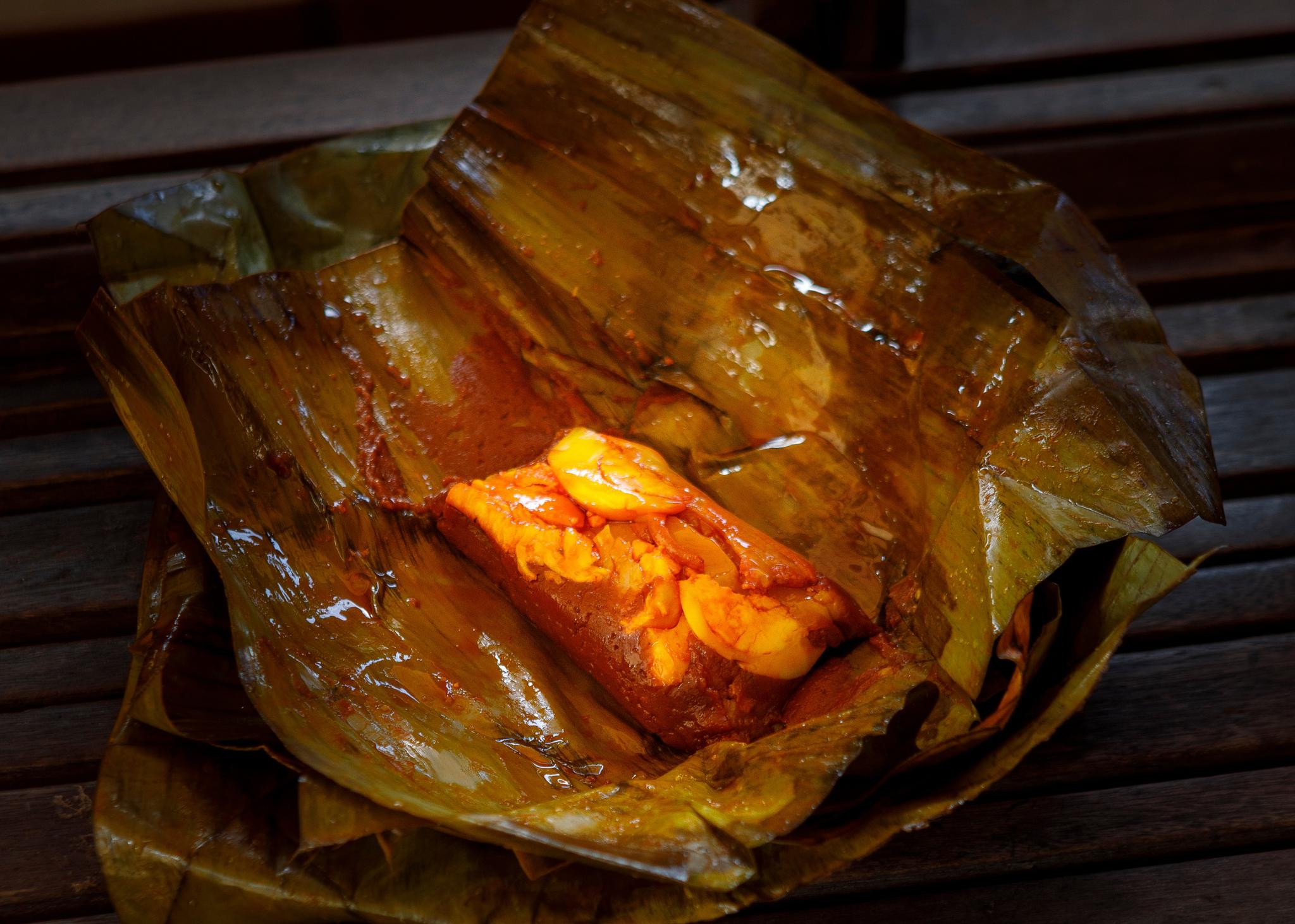Cavite Tamales from Argentina

Apu Nena, Christina Sunae's second restaurant in Buenos Aires, Argentina, centers its menu on tapas asiáticas: small plates inspired by Filipino pulutan (finger food). The accessible tapas format, familiar in Argentina and other Spanish-speaking countries, allows Sunae to introduce Filipino dishes that are rarely found on restaurant menus even within the Philippines, such as this regional variation on tamales. The comforting, all-in-one meal has proved especially popular for takeout during Buenos Aires' strict coronavirus lockdown. "It sells out almost every night," says Sunae. "They're loving it." — Jennifer Fergesen
Note: This recipe will be available in Christina Sunae's upcoming cookbook, Kusinera Filipina, which will be published in Argentina by Catapulta Editores.
Ingredients
Makes 4 tamales
For the sauce:
● 1/4 cup olive oil
● 1 1/2 tablespoons annatto (atsuete) seeds
● 2/3 cup onion, finely chopped
● 2 cloves of garlic, finely chopped
● 1 cup peanut butter
● 1 tablespoon sugar
● Ground chili, to taste
● Salt, to taste
For the filling:
● 2 longganisa sausages
● 1/4 lb pancetta or bacon
● 2 eggs, hard-boiled and cut lengthwise
For the dough:
● 1 tablespoon olive oil
● 2/3 cup onion, chopped
● 1 clove of garlic, chopped
● 7 fluid oz chicken broth
● 7 fluid oz coconut milk
● 1 1/3 cup rice flour
● Salt, to taste
For wrapping:
● 8 prepared banana leaves
● Kitchen string
Directions
- Sauce: To make annatto oil, combine annatto seeds and olive oil in a saucepan and bring heat to medium. When oil begins to bubble around the seeds, turn off the heat and allow to soak for 2 minutes. Strain out seeds.
- Bring the strained annatto oil back to medium heat and add onion and garlic. Cook until onions are translucent. Remove from heat.
- In a bowl, combine peanut butter, sugar, ground chili, salt, and cooked onion and garlic with annatto oil. Stir until well combined. Set aside.
- Filling: Place the longganisa in a pan with 2 tsp of water. Warm on medium heat until the water evaporates, then cook until the sausages are brown and caramelized on the outside. Cut in slices and set aside.
- In the same pan, cook the pancetta or bacon until it is brown and crisp. Set aside.
- Dough: Heat 1 tablespoon olive oil in a heavy saucepan and add onion and garlic. Cook until onion is translucent, then add broth and coconut milk.
- Bring the broth and coconut milk mixture to a simmer and season with salt. Then add the rice flour gradually, mixing constantly with a wooden spoon so that the mixture does not stick to the bottom of the saucepan. Continue mixing until the dough is cooked. (Test the dough by pinching a piece between your fingers; when it is cooked, it will feel smooth instead of grainy and sticky.)
- Cover the saucepan and remove from heat. When the dough has cooled enough to be manageable, remove from the pot and cover with plastic wrap.
- Wrapping: You can buy banana leaves pre-prepared for tamales, or prepare your own. For the latter, wipe the leaves with a damp cloth, trim the tough vein from the edges and cut the leaves into 8 x 8 squares. Blanch the cut leaves in a steamer for 5 minutes to make them pliable.
- Arrange 2 banana leaf squares on a clean surface. Add about 1/3 cup of the dough and 2 slices of longganisa, a slice of bacon, and half an egg. Pour over enough sauce to cover it fully, about the same volume as the dough. It is very important that the tamal has a lot of sauce, so don’t be shy!
- Close the tamale by folding the ends of the leaves over the filling. Tie with kitchen string, like a gift, and repeat until you have run out of filling or leaves. Place the tamales in a steamer and steam them on high heat for 20 minutes.
A version of this recipe appeared in Positively Filipino magazine.
Add a comment
0 Comments Add a Comment?